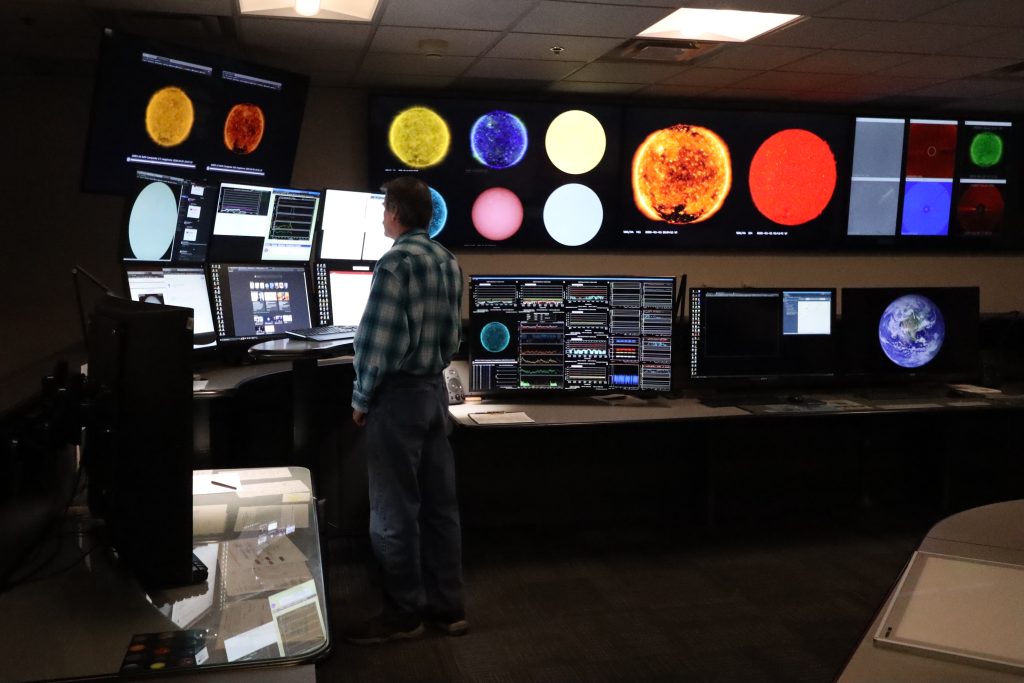
Classroom Resources: Space Weather
Get to know the Space Weather Prediction Center in Boulder
Kindergarten - 2nd Grade
- Space Weather Story Map
- Ask a Scientist: What is a solar flare?
- Ask a Scientist: How often does space weather happen?
- Ask a Scientist: How do you warn astronauts about space weather?
- Space Weather Prediction Center for Kids
- SciJinks Space Weather and Us
- Space Weather Prediction Center Education and Outreach
3rd - 5th Grade
- Space Weather Story Map
- Ask a Scientist: What is a solar flare?
- Ask a Scientist: How often does space weather happen?
- Ask a Scientist: How do you warn astronauts about space weather?
- Space Weather Prediction Center for Kids
- 5 Things: Space Weather
- SciJinks Space Weather and Us
- Space Weather Prediction Center Education and Outreach
Middle School
- Introduction to Space Weather and Space Weather Prediction Center
- Space Weather Prediction Center
- Do You NOAA: Effects of Space Weather
- Space Weather Story Map
- 5 Things: Space Weather
- Do You NOAA: Aurora
- Space Weather Impacts: Power
- Space Weather Impacts: Communications
- Space Weather Impacts: GPS
- Space Weather Prediction Center Education and Outreach
- Meet Our Team: Forecaster Shawn
- Meet Our Team: Software Engineer Kiley
High School/College
- Introduction to Space Weather and Space Weather Prediction Center
- Space Weather Prediction Center
- Do You NOAA: Effects of Space Weather
- Space Weather Story Map
- 5 Things: Space Weather
- Do You NOAA: Aurora
- Space Weather Impacts: Power
- Space Weather Impacts: Communications
- Space Weather Impacts: GPS
- Space Weather Prediction Center Education and Outreach
- Meet Our Team: Forecaster Shawn
- Meet Our Team: Software Engineer Kiley
Next Generation Science Standards
Grade Level
Standard
NOAA Boulder Science
1st
1-ESS1-1 Use observations of the sun, moon, and stars to describe patterns that can be predicted.
Space weather forecasters and researchers observe sunspot groups and can predict solar storms.
3rd
3-PS2-3 Ask questions to determine cause and effect relationships of electric or magnetic interactions between two objects not in contact with each other.
The magnetic field in a coronal mass ejection interacts with earth’s magnetic field and can induce electric currents on earth.
4th
4-PS3-2 Make observations to provide evidence that energy can be transferred from place to place by sound, light, heat, and electric currents.
During space weather events, an immense amount of light, energy and radiation leave the sun and interact with earth’s atmosphere.
Middle School
MS-PS2-3 Ask questions about data to determine the factors that affect the strength of electric and magnetic forces.
MS-PS2-5 Conduct an investigation and evaluate the experimental design to provide evidence that fields exist between objects exerting forces on each other even though the objects are not in contact.
>MS-ESS1-3 Analyze and interpret data to determine scale properties of objects in the solar system.
Space weather forecasters observe the orientation of the magnetic field in a coronal mass ejection and its overall size to determine the impacts on earth.
Space weather events travel 93 million miles to reach earth. SWPC forecasters use a satellite located 1 million miles from earth to learn about storms before they arrive.
High School
HS-PS1-8 Develop a model based on evidence to illustrate the life span of the sun and the role of nuclear fusion in the sun’s core to release energy that eventually reaches Earth in the form of radiation.
HS-PS2-5 Plan and conduct an investigation to provide evidence that an electric current can produce a magnetic field and that a changing magnetic field can produce an electric current.
HS-PS3-5 Develop and use a model of two objects interacting through electric or magnetic fields to illustrate the forces between objects and the changes in energy of the objects due to the interaction.
Space weather forecasters and researchers learn about processes on the sun that create radiation storms so they can better forecast storms and warn about potential impacts.
Electric currents are generated on earth when the magnetic field of a coronal mass ejection interacts with earth’s magnetic field.
Space researchers work to create and improve models that depict how space weather events interact with earth’s magnetic field and atmosphere.

